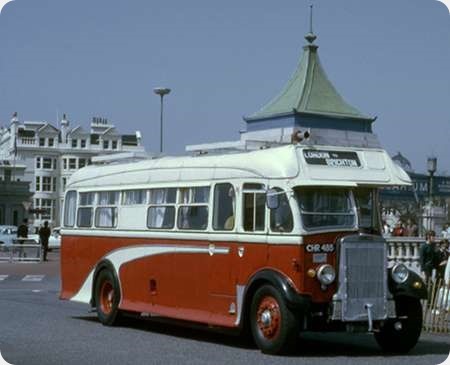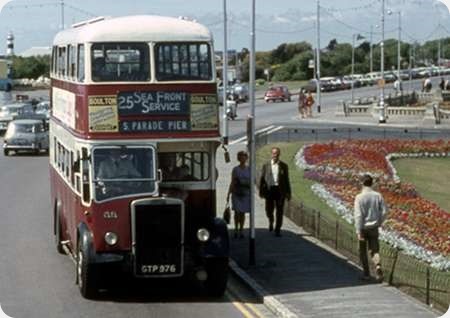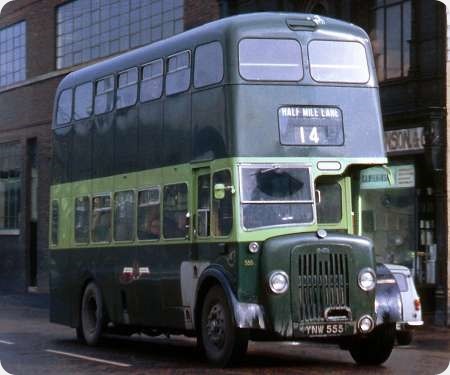Wilts & Dorset – Leyland Tiger – CHR 485
Wilts & Dorset Motor Services
1940
Leyland Tiger TS8
Harrington C32R
When photographed at Brighton during the 1970 HCVC Rally, this ex Wilts & Dorset Leyland Tiger TS8 with a Harrington C32R body had been converted into a caravan. A picture of this coach in its former glory may be found here:- www.flickr.com/photos/ingythewingy/
Although the TS8 had nominally been superseded by the TS11 in October 1939, the exigencies of war resulted in deliveries of the earlier version continuing well into 1940, when Wilts & Dorset received fleet number 186, CHR 485. The TS11 model became quite a rare beast from its eventual appearance in mid 1940, and when Leyland turned its entire resources over to war work, the final 22 TS11 chassis emerged as a result of the “unfrozen” programme in 1942. They were the very last TS type Tigers to be produced. The photo in the above link of CHR 485 in Wilts and Dorset ownership is interesting in that the glasses of the destination indicator and those of the fixed passenger windows below the opening sections have flush rubber glazing, which must surely have been a later modification to the 1940 vintage Harrington body. The same features are evident in its later guise as a caravan. I can find no current record of CHR 485 being in existence today.
Photograph and Copy contributed by Roger Cox
23/10/18 – 12:59
Sad that despite having survived till 1970 this superb Tiger is no longer around. Let’s hope that it’s sitting somewhere awaiting restoration, though I feel that that’s unlikely.
Ian Thompson
29/10/18 – 06:08
Sorry, the 1993 Slater/Godwin preserved buses list has it as "chassis only" with the South Lancashire Transport Society in 1986.
Peter Williamson
02/11/18 – 07:05
How come that W&D, I presume a Tilling company, ordered Leyland chassis and not Bristol ones?
Chris Hebbron
02/11/18 – 12:09
In pre-war days, W&D had close links with Southdown, and followed it’s purchasing policies rather than Tilling ones. Indeed, at the outbreak of war, a fair number of Southdown Leyland TD1s found their way to W&D because of the need to cover wartime service personnel services in their area [Salisbury Plain]. The 1942 split of T&BAT arrangements left W&D in the Tilling camp rather than BET.
Michael Hampton
02/11/18 – 12:10
The reason why is surely that this was before nationalisation, and I recall reading somewhere that before WWII Wilts & Dorset was heavily influenced by Southdown – a Leyland fan.
David Wragg
03/11/18 – 06:42
Thx for that, Michael/David. For some reason, most Tilling group company bus photos I’ve seen have always been Bristols, hence my query.
My experiences with Bristol buses has been very limited and greatly influenced, negatively, by the pre-war Bristol K’s on the Isle of Wight, noisy, vibrating things, which made me think that Wilts & Dorset were very wise in buying Leyland vehicles in preference! My other was riding in more civilised post-war Bristol K’s from Fareham Bus Station to Warsash when, living in Southsea, I was posted, for some bizarre reason, to RAF Calshot for a my last 6 weeks National Service!
Chris Hebbron
03/11/18 – 06:44
There were actually quite a few BTC companies that used Leylands – Cumberland, Lincolnshire, Western and Southern National – and even Bristol Tramways & Carriage Company itself!
Stephen Ford
04/11/18 – 07:24
The Slater/Goodwin book told a partially correct story.
The chassis of CHR 485 came to the South Lancashire Transport Society from the well known Bolton PSV dealer – Lister’s. It was acquired as a donor vehicle to aid the restoration of Ribble Tiger 209 (1400), RN 7588. Upon completion of RN, the chassis of CHR was stripped for anything useable and scrapped locally.
Mike Norris
12/12/18 – 08:49
United also had many Leylands, especially fir their London coach services.
Peter Stobart
26/01/19 – 10:02
I remember seeing what remained of CHR 485 at an open day where preserved buses were kept around 1983 at Bolton (Smithills Road rings a bell, please forgive me if I am incorrect). By this time only the front of the cab & chassis remained, great pity when it looked so nice thirteen years earlier & could have been put back to original
Andrew Spriggs
I was very surprised to see a photo of CHR 485 on your page. I and two colleagues bought this bus from Norman Myers (Bolton) in 1973 with a view to restoring it. It was our first venture into restoration however the enthusiasm of our then youth was not matched by any experience and we had to admit defeat after at couple of years when we sold it on. CHR 485 was rebodied by Portsmouth Aviation hence the unusual window panels, however it had been later altered to transport racing cars so the interior had been stripped out and the rear end substantially modified. The engine still ran when we acquired it however we discovered a substantial crack in the block which looked very expensive for our modest means. I have always wondered what became of it and am pleased to learn that it was a useful donor vehicle although would have loved to see it back to working condition.
Time moves on and I have since acquired and restored a Warrington PD1 (EED 5) that I have now owned for over 40 years and which continues to attend several rallies each year.
Phil Clark



